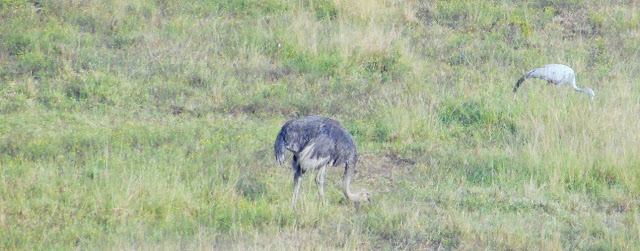Despite being the third largest city in the Country, Durban is blessed
with an abundance of wildlife, this may be down to the coastline but is more
likely down to the abundance of parks, gardens and D’moss areas which are
little island sanctuaries amidst the concrete. There are even troops of monkeys
terrorising the neighborhood in the city.
The beaches offer good birding and the parks and reserves equally so.
This first entry was a visit on a Sunday afternoon for a quick walk and some
lunch towards the South of Durban’s beaches. Its generally warm to hot and
quite humid in this area, the bordering Indian Ocean effectively prevents
winter from happening at all..
Archaeological evidence from the Drakensberg Mountains suggests that the
Durban area has been inhabited by communities of hunter-gatherers since 100,000
BC. These people lived throughout the area of present-day KwaZulu-Natal until
the expansion of Bantu farmers from the north saw their
gradual displacement, incorporation or extermination.
Little is known of the history of the first residents, as there is no
written history of the area until it was sighted by Portuguese explorer Vasco
da Gama, who sailed parallel to the KwaZulu-Natal coast at Christmastide in
1497 while searching for a route from Europe to India. He named the area
"Natal", or Christmas in Portuguese.
The modern city of Durban dates from 1824, when a party of 25 men under
British Lieutenant F. G. Farewell arrived from the Cape Colony and established
a settlement on the northern shore of the Bay of Natal, near today's Farewell
Square. Accompanying Farewell was an adventurer named Henry Francis Fynn. Fynn
was able to befriend the Zulu King Shaka by helping him to recover from a stab
wound he suffered in battle. As a token of Shaka's gratitude, he granted Fynn a
"30-mile [50 km] strip of coast a hundred miles [160 km] in depth."
During a meeting of 35 European residents in Fynn's territory on 23 June
1835, it was decided to build a capital town and name it "d'Urban"
after Sir Benjamin d'Urban, then governor of the Cape Colony. And so that’s
that…
Today, Durban is the busiest container port in Africa. The Golden Mile,
developed as a welcoming tourist destination in the 1970s, as well as Durban at
large, provide ample tourist attractions, particularly for people on holiday
from Gauteng. The Golden Mile was redeveloped in late 2009 in time for the 2010
FIFA World Cup. It was resurfaced and widened between Ushaka Marine World and
Moses Mabhida Stadium. Durban's most popular beaches are also located along the
Golden Mile.
BLACK HEADED AND GREY HEADED GULLS, MARKWELL
AFRICAN SPOONBILL, MARKWELL
CASPIAN TERN, MARKWELL
GREY HEADED GULLS, MARKWELL
NOT TOO SURE ...
NOT TOO SURE
































































